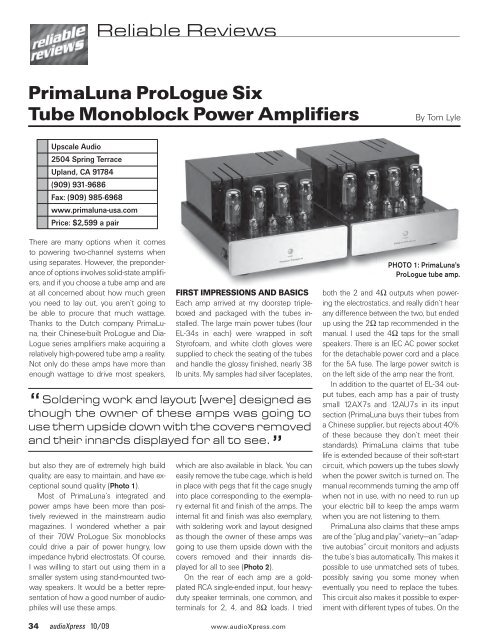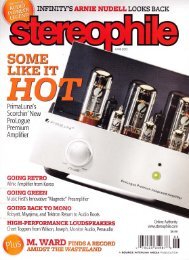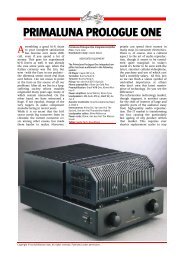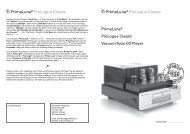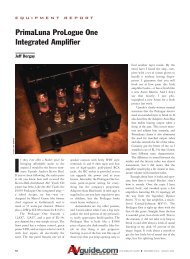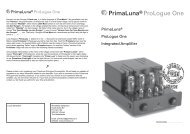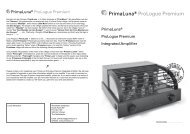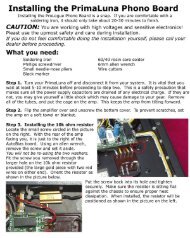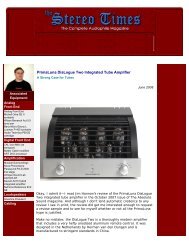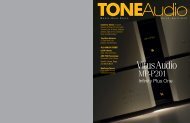PrimaLuna ProLogue Six Tube Monoblock Power Amplifiers
PrimaLuna ProLogue Six Tube Monoblock Power Amplifiers
PrimaLuna ProLogue Six Tube Monoblock Power Amplifiers
You also want an ePaper? Increase the reach of your titles
YUMPU automatically turns print PDFs into web optimized ePapers that Google loves.
Reliable Reviews<br />
<strong>PrimaLuna</strong> <strong>ProLogue</strong> <strong>Six</strong><br />
<strong>Tube</strong> <strong>Monoblock</strong> <strong>Power</strong> <strong>Amplifiers</strong> By Tom Lyle<br />
Upscale Audio<br />
2504 Spring Terrace<br />
Upland, CA 91784<br />
(909) 931-9686<br />
Fax: (909) 985-6968<br />
www.primaluna-usa.com<br />
Price: $2,599 a pair<br />
There are many options when it comes<br />
to powering two-channel systems when<br />
using separates. However, the preponderance<br />
of options involves solid-state amplifiers,<br />
and if you choose a tube amp and are<br />
at all concerned about how much green<br />
you need to lay out, you aren’t going to<br />
be able to procure that much wattage.<br />
Thanks to the Dutch company <strong>PrimaLuna</strong>,<br />
their Chinese-built <strong>ProLogue</strong> and Dia-<br />
Logue series amplifiers make acquiring a<br />
relatively high-powered tube amp a reality.<br />
Not only do these amps have more than<br />
enough wattage to drive most speakers,<br />
but also they are of extremely high build<br />
quality, are easy to maintain, and have exceptional<br />
sound quality (Photo 1).<br />
Most of <strong>PrimaLuna</strong>’s integrated and<br />
power amps have been more than positively<br />
reviewed in the mainstream audio<br />
magazines. I wondered whether a pair<br />
of their 70W <strong>ProLogue</strong> <strong>Six</strong> monoblocks<br />
could drive a pair of power hungry, low<br />
impedance hybrid electrostats. Of course,<br />
I was willing to start out using them in a<br />
smaller system using stand-mounted twoway<br />
speakers. It would be a better representation<br />
of how a good number of audiophiles<br />
will use these amps.<br />
FIRST IMPRESSIONS AND BASICS<br />
Each amp arrived at my doorstep tripleboxed<br />
and packaged with the tubes installed.<br />
The large main power tubes (four<br />
EL-34s in each) were wrapped in soft<br />
Styrofoam, and white cloth gloves were<br />
supplied to check the seating of the tubes<br />
and handle the glossy finished, nearly 38<br />
lb units. My samples had silver faceplates,<br />
“ Soldering work and layout [were] designed as<br />
though the owner of these amps was going to<br />
use them upside down with the covers removed<br />
and their innards displayed for all to see. ”<br />
which are also available in black. You can<br />
easily remove the tube cage, which is held<br />
in place with pegs that fit the cage snugly<br />
into place corresponding to the exemplary<br />
external fit and finish of the amps. The<br />
internal fit and finish was also exemplary,<br />
with soldering work and layout designed<br />
as though the owner of these amps was<br />
going to use them upside down with the<br />
covers removed and their innards displayed<br />
for all to see (Photo 2).<br />
On the rear of each amp are a goldplated<br />
RCA single-ended input, four heavyduty<br />
speaker terminals, one common, and<br />
terminals for 2, 4, and 8Ω loads. I tried<br />
34 audioXpress 10/09 www.audioXpress.com<br />
PHOTO 1: <strong>PrimaLuna</strong>’s<br />
<strong>ProLogue</strong> tube amp.<br />
both the 2 and 4Ω outputs when powering<br />
the electrostatics, and really didn’t hear<br />
any difference between the two, but ended<br />
up using the 2Ω tap recommended in the<br />
manual. I used the 4Ω taps for the small<br />
speakers. There is an IEC AC power socket<br />
for the detachable power cord and a place<br />
for the 5A fuse. The large power switch is<br />
on the left side of the amp near the front.<br />
In addition to the quartet of EL-34 output<br />
tubes, each amp has a pair of trusty<br />
small 12AX7s and 12AU7s in its input<br />
section (<strong>PrimaLuna</strong> buys their tubes from<br />
a Chinese supplier, but rejects about 40%<br />
of these because they don’t meet their<br />
standards). <strong>PrimaLuna</strong> claims that tube<br />
life is extended because of their soft-start<br />
circuit, which powers up the tubes slowly<br />
when the power switch is turned on. The<br />
manual recommends turning the amp off<br />
when not in use, with no need to run up<br />
your electric bill to keep the amps warm<br />
when you are not listening to them.<br />
<strong>PrimaLuna</strong> also claims that these amps<br />
are of the “plug and play” variety—an “adaptive<br />
autobias” circuit monitors and adjusts<br />
the tube’s bias automatically. This makes it<br />
possible to use unmatched sets of tubes,<br />
possibly saving you some money when<br />
eventually you need to replace the tubes.<br />
This circuit also makes it possible to experiment<br />
with different types of tubes. On the
Reliable Reviews<br />
distributor’s website, they claim you can<br />
use 6550, KT88, KT90, 6L6GC, KT66,<br />
7581, or even 6V6GT tubes instead of<br />
the EL-34s. [Manufacturer’s note: Though<br />
the <strong>PrimaLuna</strong> is fine with 6V6GT tubes,<br />
we are no longer recommending those<br />
because there are some low quality ones<br />
out there, and instead, we recommend EL-<br />
37—Kevin Deal, <strong>PrimaLuna</strong> USA].<br />
The custom output transformers were<br />
designed by an American engineer, then<br />
the final design was done by Marcel Croese,<br />
who supposedly is a very renowned<br />
transformer designer. A good transformer<br />
design should lower the noise floor and<br />
extend the frequency response.<br />
<strong>PrimaLuna</strong> says that the <strong>ProLogue</strong><br />
<strong>Six</strong>es have a “dual-feedback topology”<br />
which is a cross-coupled current feedback<br />
for superior impulse behavior and<br />
gain stability. A slight amount of negative<br />
feedback is used to achieve exact gain<br />
setting, low distortion, and low output<br />
impedance. <strong>PrimaLuna</strong> claims that this<br />
effectively cancels the negative side effects<br />
associated with both feedback circuits.<br />
The end result utilizes all the benefits<br />
of feedback without the drawbacks.<br />
The <strong>ProLogue</strong> <strong>Six</strong> is made with many<br />
quality parts. For example, no plastic<br />
tube sockets here, only ceramic sockets<br />
are mounted on the chassis. Internally,<br />
<strong>PrimaLuna</strong> uses Nichicon and Realcap<br />
capacitors, a toroidal transformer, and<br />
the amp is handmade with non-cost-effective<br />
point-to-point wiring throughout.<br />
LISTENINg—SySTEM ONE<br />
The smaller of the two systems consists<br />
PHOTO 2: Inside the <strong>ProLogue</strong> amp.<br />
of a digital front end (Arcam) and an analog<br />
front end of an old FM tuner (AR),<br />
either a solid-state (Jeff Rowland Designs)<br />
or tube (Balance Audio Technologies)<br />
preamp. The speakers I used were<br />
Dynaudio Focus 110.<br />
If you are interested, the preamp-toamp<br />
interconnects are Cardas, the CD to<br />
preamp is Monster Cable, and the tuner is<br />
connected with out-of-the-box-type cable.<br />
The speaker cable is sometimes Kimber,<br />
sometimes Monster. I use the stock power<br />
cords and no power conditioner. The<br />
PSB speaker stands are filled with marble<br />
gravel, and all the other equipment sits<br />
on the hardwood floor atop and separated<br />
by antique Audio-Technica pucks.<br />
While the amps were in either system,<br />
I heard no complaints—there were no<br />
buzzes, hiccups, static, or any extraneous<br />
noises at any time. I could hear no<br />
background noise other than a slight hiss<br />
when I turned up the volume on the preamp<br />
and put my ears up to the speakers.<br />
Other components could have contributed<br />
to this background noise.<br />
After they were just about fully broken<br />
in, which took about two weeks of on<br />
and off use, the <strong>PrimaLuna</strong> <strong>ProLogue</strong> <strong>Six</strong>es<br />
sounded magnificent in this system—<br />
even when listening to the FM tuner,<br />
which was usually set to the local jazz<br />
station WBGO in Newark, N.J. (terrestrial<br />
out-and-out jazz stations are very scarce<br />
these days). On one occasion there was<br />
a solo tenor sax playing (I think it was a<br />
recent Sonny Rollins release). Its sound<br />
entered the room with such a pure tone<br />
it was disquieting.<br />
When using the CD player, of<br />
course, things became better.<br />
One high point was Wilco’s Yankee<br />
Hotel Foxtrot. When playing<br />
this CD the system sounded<br />
alive: the treble had a natural<br />
timbre, and both the mids and<br />
highs had a rightness that made<br />
this disc sound as good as it ever<br />
has—with a tube sweetness that<br />
was addictive. This tube sweetness<br />
was not a euphonic coloration,<br />
but it included as one of<br />
its features a less forward sound<br />
that diminished listening fatigue to a<br />
point that made for some very long listening<br />
sessions.<br />
When I played orchestral discs such<br />
as Sibelius’ symphonies with Colin Davis<br />
conducting the LSO on RCA, the string<br />
sound was luscious in large part because<br />
midrange was so accurately portrayed.<br />
There was no loss in resolution anywhere<br />
in any frequency, and there was an abundance<br />
of what I like to call “dynamic distance”<br />
between sounds—that is, the separation<br />
of two or more instruments playing<br />
simultaneously but at different volumes.<br />
I could kick out the jams, too, playing<br />
“Wasted Years ‘99” from Iron Maiden’s<br />
Best of the B-Sides, which was included<br />
in the Iron Maiden box set (packaged in<br />
a metal casket, by the way). There was<br />
plenty of power displayed in the crunching<br />
guitars and thunderous rhythm section.<br />
The non-pumped-up midbass shook<br />
the air, which says a lot for the superb<br />
speakers, at least from 40Hz on up.<br />
When I came back to earth, I played the<br />
Kronos Quartet’s album Pieces of Africa,<br />
and reveled in the sound of the individual<br />
strings and percussion instruments clearly<br />
portrayed in the space of the proportionally<br />
scaled soundstage. I’m not going to<br />
say that the instruments sounded indistinguishable<br />
from the real thing—that’s<br />
ridiculous—but it sure was impressive how<br />
lifelike this CD sounded in this relatively<br />
modest system. The <strong>PrimaLuna</strong>s and the<br />
Dynaudios were a perfect match.<br />
LISTENINg—SySTEM TwO<br />
This system is in my main listening room<br />
and consists of analog (Basis/Tri-planar/<br />
Lyra turntable setup and an NAD FM<br />
tuner) and digital (Arcam and Oppo) front<br />
ends, a tube preamp (Balance Audio Technologies),<br />
and Sound Lab Dynastat hybrid<br />
electrostatic speakers, sometimes augmented<br />
by a Velodyne sub. If you care, the<br />
interconnects are either MIT or Virtual Dynamics,<br />
the speaker cable MIT, power cables<br />
Virtual Dynamics and MIT, and all the<br />
equipment is plugged into either PS Audio<br />
<strong>Power</strong> Plants or a Chang Lightspeed conditioner.<br />
Then these are plugged into Virtual<br />
Dynamics wall receptacles with two<br />
audioXpress October 2009 35
Reliable Reviews<br />
dedicated 15A lines. Most of the equipment<br />
rests on an Arcici Suspense equipment<br />
rack, and the room is treated with<br />
Echo Busters acoustical panels.<br />
When I first had the amps in this system,<br />
I was careful. I didn’t want to judge<br />
the amps too harshly with complex material,<br />
so along with some other small combo<br />
recordings, I played an LP of Julliard<br />
String Quartet’s version of Bartok’s String<br />
Quartet No. 6. The amps sounded good,<br />
but they had a more burnished, laid-back<br />
sound than I was used to. But they were<br />
reasonably neutral sounding, a little rolled<br />
off in the highs (which as a benefit reduced<br />
the background noise on the old<br />
record), and a little less defined in the<br />
midrange and mid-bass than absolute,<br />
but the overall sound was very good.<br />
As far as the decrease in treble energy,<br />
nobody is going to describe the Sound<br />
Lab speakers I use as bright sounding;<br />
some might even say they are a little rolled<br />
off. I disagree. I find them to be extremely<br />
transparent in the treble region, but I’ve<br />
used them as my reference for years, so<br />
I’m probably used to them.<br />
Nevertheless, when I played the SACD<br />
layer of Stokowski’s Rhapsodies album, a<br />
Living Stereo re-issued by BMG, the sound<br />
of the solo instruments on an excerpt from<br />
Wagner’s Tristan and Isolde sounded rather<br />
lifelike—especially the English horn—and<br />
I could clearly sense the ambience of NYC’s<br />
Manhattan Center. The amps were able to<br />
sort out more complex fare—even when I<br />
threw on some convoluted rock (or whatever<br />
you want to call it) such as Frank Zappa’s<br />
Weasels Ripped My Flesh. The amps kept<br />
their composure (even when the musicians<br />
did not) while playing this thorny music.<br />
But, even with all their positive traits, I<br />
wasn’t totally blown away. They were just<br />
too rolled off in the highs for my taste, and<br />
the midrange was a tad too recessed. I<br />
could only chalk that up to a combination<br />
of the speaker’s relatively soft highs<br />
(although, again, I’m prepared to debate<br />
36 audioXpress 10/09 www.audioXpress.com<br />
that fact), perhaps their demand for high<br />
power, and their challenging impedance<br />
characteristics.<br />
TUBE SwITCH<br />
When speaking to the US distributor of<br />
the <strong>PrimaLuna</strong>, Upscale Audio’s Kevin<br />
Deal, I think he sensed my lack of enthusiasm<br />
for the combination of the <strong>ProLogue</strong><br />
<strong>Six</strong>es and the Sound Labs. He said he’d<br />
send me a set of <strong>PrimaLuna</strong> KT88 power<br />
tubes to try out instead of the stock EL-<br />
34s. They arrived about five days later,<br />
and I installed them forthwith.<br />
The improvement in the sound of the<br />
amps was extraordinary. The midrange<br />
reached a more natural level and was<br />
much more defined, and the highs were<br />
restored to a point where their extension<br />
nearly rivaled a solid-state amp, yet instruments<br />
within both frequencies were<br />
rendered with what I can only describe<br />
as tube sweetness. It was a very lifelike<br />
sound, which included excellent separa-
tion of individual instruments and groups<br />
of instruments. There was ample power in<br />
the bass, and the overall sound of the amps<br />
was extremely inviting.<br />
I played a new favorite of mine—Nine Inch<br />
Nails’ Year Zero CD. The album came across<br />
as aggressive and relentless, which was as it<br />
should be. Turned up nice and loud, the bass<br />
shook the walls. Synths and the hammering<br />
percussion sounds were upfront and distinct,<br />
yet incorporated into the dense mix to form<br />
the intense wall of sound. Wonderful stuff.<br />
The sometimes raucous CD of Prokofiev’s<br />
complete soundtrack of Alexander Nevsky<br />
with Uri Temirkanov conducting the St. Petersburg<br />
PO was superb. Like the NIN, this<br />
is a dense recording (Romeo and Juliet, it<br />
ain’t), yet the <strong>ProLogue</strong> <strong>Six</strong>es had no problem<br />
sorting out the orchestra, chorus, and<br />
soloists. But in contrast to the NIN the participants<br />
and the space were real, and it was<br />
like I had a tenth row seat during the recording<br />
session. The highs were sweet and credible<br />
and the mids were well sorted out in the<br />
very intricate, large soundstage.<br />
I loaded the Zappa disc again, and was<br />
reminded that the recording was a bit<br />
bright. But despite this, it was almost as<br />
though I was listening to a live mike feed<br />
in the studio rather than a CD. The drums,<br />
in particular, were outstanding, in part because<br />
the transient response was surprisingly<br />
good; there was a snap to the sound<br />
that I wasn’t expecting from a tube amp.<br />
I also spun the best pressing I have of Jimi<br />
Hendrix’s Axis Bold as Love LP, a mono pressing<br />
reissued by Classic Records (vinyl, tubes,<br />
mono—please help me). This version, of course,<br />
disposes of the psychedelic hard left-right panning<br />
and presents the album in a much more<br />
listenable arrangement. I was able to follow<br />
and dissect all the overdubbed guitar and effects.<br />
But especially good was “Little Wing,”<br />
which wasn’t laden with overdubs and let me<br />
hear all that engineer Eddie Kramer dialed into<br />
the mix, particularly the goose-bump-raising<br />
flanged guitar. I admit that the recording quality<br />
isn’t the greatest, and the <strong>PrimaLuna</strong>s did<br />
not fail to disclose that fact.<br />
Because I was stuck in the 1960s for much<br />
of my listening of late, I played “India”—the<br />
first cut on Coltrane’s Impressions album<br />
on a Japanese Impulse pressing, recorded<br />
���������������������<br />
���������������������������������<br />
�������������������������<br />
���������������������<br />
���������������������������<br />
����������������������������<br />
���������������������<br />
����������������������������������������������������<br />
��������������������������������������������������������<br />
������������������������������������������������������<br />
���������������������������������������������������������<br />
������������������������������������������<br />
� �� ��������������������<br />
� �� �������������������������������������<br />
� �� ������������������<br />
� �� �����������������������������<br />
�����������������������������������������<br />
�����������������<br />
��������������<br />
�����������������������<br />
�����������������������������<br />
����������������������������������<br />
�����������������������������<br />
audioXpress October 2009 37
Reliable Reviews<br />
at the Village Vanguard in 1961. The track<br />
takes up most of side one (John Coltrane<br />
and Eric Dolphy together—it doesn’t get<br />
much better than this).<br />
Even though the highs were a smidge<br />
softer than I’m used to, they were very revealing,<br />
and there was lots of air around the<br />
horns. The low end and mid-bass were also<br />
fine; the dual basses of Reggie Workman<br />
and Jimmy Garrison weren’t too meshed<br />
together, so it was possible to identify<br />
each instrument. The recording quality is<br />
very good; I just wish McCoy Tyner’s piano<br />
wasn’t mixed so low. The vinyl is silent, with<br />
the only background noise being the tape<br />
hiss which the <strong>PrimaLuna</strong>s made clearly<br />
evident. (Depending on how you look at it<br />
this was or was not a good thing.)<br />
As I continued to live with the amps,<br />
I realized there wasn’t any type of music<br />
that could trip them up, and the more I<br />
used them, the more I appreciated their<br />
sound. CD after CD, record after record,<br />
the midrange had an impressive ability to<br />
separate out all the instruments in any mix,<br />
and both the mids and the highs exhibited<br />
the tube magic that I’ve come to expect<br />
from a great valve amp. This “tube magic”<br />
wasn’t the old-school-type of tube sound—<br />
rolled off in the bass and highs, and their<br />
only strength the midrange—it was more<br />
that instruments had that dynamic distance<br />
I mentioned when using them in<br />
the smaller system, combined with less<br />
in-your-face forwardness than the majority<br />
of affordable solid-state amps.<br />
I was skeptical; I’ve had other tube<br />
amps paired with these speakers before,<br />
all with less power than the <strong>PrimaLuna</strong>s<br />
and with mixed results. But still, even with<br />
70W per channel, I didn’t think the <strong>Six</strong>es<br />
would have enough power to drive a pair<br />
of these rather large electrostatic/dynamic<br />
speakers. I was wrong.<br />
I needed to turn up the volume on the<br />
preamp higher than I did with a 250W<br />
per channel solid-state power amp, but<br />
this did not in any way increase the background<br />
noise. I had no trouble reaching<br />
the volume limits of the speakers, which<br />
was quite loud—loud enough for me to<br />
back off a little to prevent possible hearing<br />
damage. What I can’t explain is why I<br />
didn’t need to turn up the volume so loud.<br />
I could listen to music at lower dBs with<br />
the <strong>Six</strong>es than I was accustomed to, and<br />
still consider it to be an acceptable level.<br />
CONCLUSION<br />
I think many audiophiles will like the fact<br />
that simply swapping tubes can have such<br />
a dramatic effect on the sound; I could only<br />
imagine what a field day a tube roller would<br />
have swapping different brands and vintages.<br />
Others will not want to mess with such<br />
stuff, and I guess they’ll just have to stick<br />
with the stock tubes or use a solid-state<br />
amp. I can appreciate both worlds. But I<br />
must admit that after replacing the KT88s<br />
with the stock EL-34 tubes and bringing the<br />
amps downstairs again to use with smaller<br />
speakers, it was a better match. They spent<br />
a lot of time in that system, and I could live<br />
with these amps forever.<br />
Ultimately, I preferred the control and<br />
power of the solid-state muscle amp in<br />
the big system; I think that’s a matter of<br />
taste more than which one was “better.”<br />
There is a chance that you might prefer<br />
the <strong>PrimaLuna</strong>s with your large electrostatic<br />
speakers, even with the warmersounding<br />
stock EL-34s installed. I preferred<br />
the tubed <strong>PrimaLuna</strong>s by a wide<br />
margin in the smaller system.<br />
But wait—if you have the money, the<br />
next step up is the <strong>PrimaLuna</strong> <strong>ProLogue</strong><br />
Seven mono amps that come standard<br />
with KT88s and upgraded internal parts,<br />
also at 70W per channel, for $3149.<br />
Loading up a pair of <strong>ProLogue</strong> <strong>Six</strong>es<br />
with <strong>PrimaLuna</strong> KT88 tubes will cost you<br />
about $280, so the price comes within<br />
shouting distance of the <strong>ProLogue</strong> Sevens.<br />
I’m not totally sure, but it seems that<br />
the Sevens might be the more sensible<br />
choice when used with large speakers.<br />
Still, the majority of customers will use<br />
them with more efficient speakers, and to<br />
them I give the <strong>PrimaLuna</strong> <strong>ProLogue</strong> <strong>Six</strong>es<br />
my highest recommendation. From my evaluations,<br />
using them with large speakers is<br />
not out of the question, and quite sensible<br />
if you have a hankering for tubes and don’t<br />
want to take out a second mortgage to do<br />
so. I’m not going to pretend that $2600 is<br />
pocket change, but the <strong>PrimaLuna</strong> <strong>ProLogue</strong><br />
38 audioXpress 10/09 www.audioXpress.com<br />
<strong>Six</strong> monoblocks are worth every penny.<br />
Manufacturer’s response:<br />
All of us associated with <strong>PrimaLuna</strong> wish to graciously<br />
thank Tom Lyle and audioXpress for the<br />
thorough and thoughtful review of the <strong>ProLogue</strong><br />
<strong>Six</strong> <strong>Monoblock</strong> <strong>Power</strong> <strong>Amplifiers</strong>. When Tom<br />
writes that the amps “sounded magnificent,” that<br />
“. . . there wasn’t any type of music that could trip<br />
them up,” and that his experience was “. . . like<br />
I had a tenth row seat during the recording session,”<br />
we all can only smile because in a nutshell,<br />
he articulates exactly what we’re all about.<br />
We’re especially pleased that Tom spent the<br />
time and effort to evaluate the amps in two systems.<br />
It comes as no surprise to us that the Pro-<br />
Logue <strong>Six</strong>es performed magnificently in both.<br />
We’d like to highlight one of those evaluations—his<br />
experience with the Dynastat electrostatic<br />
speakers—because it illustrates a wonderful<br />
point. Tom states that initially, he was not<br />
particularly thrilled with the EL34-based monoblocks<br />
pushing the Dynastats—the highs were<br />
“a little too rolled off” and the mid “a tad too<br />
recessed.” He speculated that perhaps it was the<br />
speaker’s demand for high power or maybe their<br />
challenging impedance characteristics. We suggested<br />
switching tubes and shipped him a set of<br />
stock <strong>PrimaLuna</strong> KT88s. And night turned to day.<br />
Tom writes that the improvement in sound “was<br />
extraordinary” and then spent the next 10 paragraphs<br />
raving about the amps’ characteristics.<br />
The point to be taken from this is that you never<br />
know what kind of speakers you may wind up<br />
with. All <strong>PrimaLuna</strong> products can be tweaked—<br />
nudged, if you will, in a particular direction and<br />
that gentle nudge can be exactly what turns a<br />
mundane experience into an extraordinary one.<br />
We sincerely appreciate Tom’s willingness to<br />
recommend these monoblocks for use with power-hungry<br />
speakers like the Dynastats; I have yet to<br />
find a speaker the <strong>ProLogue</strong> <strong>Six</strong>es can’t drive. I’ve<br />
paired it beautifully with my Sonus faber Guarneris<br />
and have heard raves from people who use it to<br />
drive difficult loads such as Martin Logan Vantages<br />
(impedance—4Ω, 1 at 20kHz).<br />
Thanks again for the glowing evaluation. When<br />
a reviewer is moved from non-plussed to ecstatic<br />
by simply switching tubes, we know we’ve created<br />
something special.<br />
Kevin Deal<br />
<strong>PrimaLuna</strong>, USA<br />
rr


